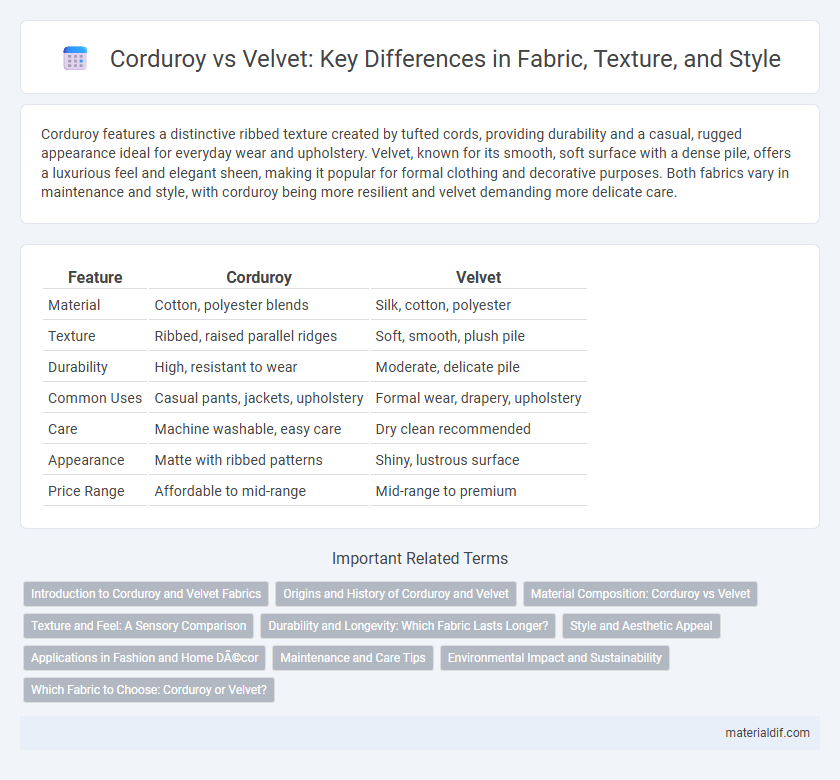Corduroy features a distinctive ribbed texture created by tufted cords, providing durability and a casual, rugged appearance ideal for everyday wear and upholstery. Velvet, known for its smooth, soft surface with a dense pile, offers a luxurious feel and elegant sheen, making it popular for formal clothing and decorative purposes. Both fabrics vary in maintenance and style, with corduroy being more resilient and velvet demanding more delicate care.
Table of Comparison
| Feature | Corduroy | Velvet |
|---|---|---|
| Material | Cotton, polyester blends | Silk, cotton, polyester |
| Texture | Ribbed, raised parallel ridges | Soft, smooth, plush pile |
| Durability | High, resistant to wear | Moderate, delicate pile |
| Common Uses | Casual pants, jackets, upholstery | Formal wear, drapery, upholstery |
| Care | Machine washable, easy care | Dry clean recommended |
| Appearance | Matte with ribbed patterns | Shiny, lustrous surface |
| Price Range | Affordable to mid-range | Mid-range to premium |
Introduction to Corduroy and Velvet Fabrics
Corduroy is a durable fabric characterized by its distinct raised "cords" or ribs, made from woven cotton or cotton blends offering a textured, ridged surface ideal for casual to semi-formal wear. Velvet, known for its soft, luxurious pile, is created from woven yarns such as silk, cotton, or synthetic fibers, providing a smooth, rich texture favored in upholstery and elegant clothing. Both fabrics differ significantly in texture, appearance, and typical use, with corduroy emphasizing rugged comfort and velvet highlighting opulence and softness.
Origins and History of Corduroy and Velvet
Corduroy traces its origins to 18th-century England, where it evolved from a fabric called "cord du roi," meaning "king's cord," prized for its durability and distinctive ridged texture. Velvet, with roots dating back to ancient civilizations such as Egypt and the Byzantine Empire, became synonymous with luxury and nobility due to its soft pile and intricate weaving techniques. Both fabrics have rich historical significance, with corduroy traditionally serving workwear purposes and velvet often reserved for royal and ceremonial garments.
Material Composition: Corduroy vs Velvet
Corduroy is typically made from cotton or a cotton blend, characterized by its durable, ribbed texture formed by twisted fibers. Velvet, on the other hand, is composed of silk, nylon, or polyester, creating a smooth, soft surface with a dense pile. The differing material compositions result in corduroy's robust and breathable quality versus velvet's luxurious, plush feel.
Texture and Feel: A Sensory Comparison
Corduroy features distinct vertical ridges known as wales, providing a textured, ribbed surface that feels firm yet soft to the touch, ideal for structured garments. Velvet offers a smooth, plush pile with a luxurious, dense softness that glides across the skin, creating a warm and elegant sensory experience. Both fabrics deliver unique tactile sensations, with corduroy emphasizing durability and texture while velvet prioritizes smoothness and opulence.
Durability and Longevity: Which Fabric Lasts Longer?
Corduroy is known for its durability due to its thick, ribbed texture made from twisted fibers that withstand wear and tear effectively. Velvet, while luxurious and soft, tends to wear out faster because of its delicate pile that can crush and mat over time. For long-lasting fabric options, corduroy generally outperforms velvet in maintaining appearance and structural integrity.
Style and Aesthetic Appeal
Corduroy features distinct vertical ridges that create a casual, textured look ideal for vintage or rugged styles, while velvet offers a smooth, lustrous surface that exudes luxury and sophistication suitable for formal or elegant clothing. The matte finish of corduroy adds depth and warmth, contrasting with velvet's reflective sheen that enhances color richness and visual opulence. Both fabrics influence outfit aesthetics significantly by contributing unique tactile and visual experiences to garments and home decor.
Applications in Fashion and Home Décor
Corduroy offers durability and a textured, ribbed surface ideal for casual wear, jackets, and upholstery, making it a favorite in both fashion and home decor for its cozy yet rugged appeal. Velvet provides a luxurious, smooth finish with a rich sheen that enhances eveningwear, drapes, and decorative pillows, lending elegance and sophistication to interiors and apparel. The choice between corduroy and velvet depends on the desired aesthetic and functional needs, with corduroy suiting rustic and casual themes, while velvet aligns with opulent and formal styles.
Maintenance and Care Tips
Corduroy requires regular brushing to remove lint and prevent fabric wear, and it is best cleaned with gentle machine washing or dry cleaning to maintain its ribbed texture. Velvet demands careful maintenance, including professional dry cleaning, as water and heat can damage its delicate pile, and it benefits from steaming to restore its soft appearance. Both fabrics should be stored away from direct sunlight to avoid fading and kept in a cool, dry place to prevent mold and mildew growth.
Environmental Impact and Sustainability
Corduroy, typically made from cotton, has a moderate environmental impact due to the water-intensive cultivation of cotton and pesticide use, though organic cotton options reduce this footprint. Velvet, often produced from synthetic fibers like polyester, contributes to microplastic pollution and relies on non-renewable petrochemicals, increasing its ecological burden. Choosing organic corduroy or plant-based velvet alternatives enhances sustainability by minimizing resource consumption and environmental toxins.
Which Fabric to Choose: Corduroy or Velvet?
Corduroy offers durability and a casual texture with its distinct ribbed pattern, making it ideal for everyday wear and upholstery that requires resilience. Velvet provides a luxurious, soft feel and rich appearance suitable for formal garments and elegant home decor. Choosing between corduroy and velvet depends on the desired aesthetic and functionality, with corduroy excelling in ruggedness and velvet prioritizing opulence.
corduroy vs velvet Infographic

 materialdif.com
materialdif.com